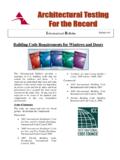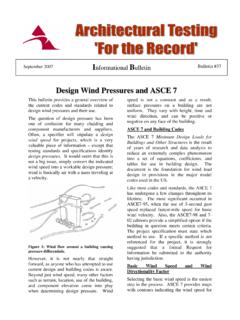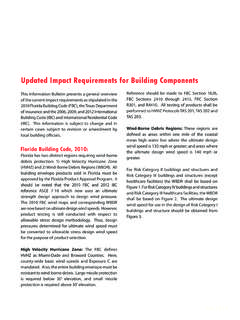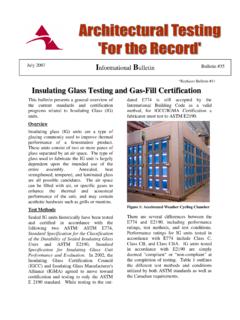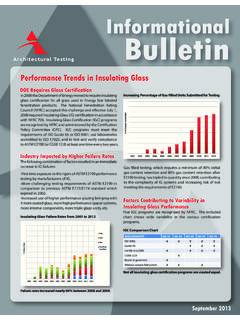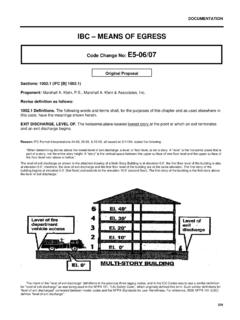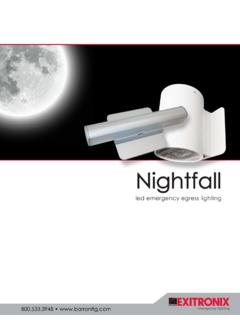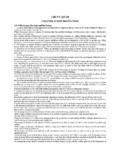Transcription of Updated Residential Egress Requirements
1 Informational Bulletin May 2007 Bulletin #33 *Replaces Informational Bulletin #7 UUppddaatteedd RReessiiddeennttiiaall EEggrreessss RReeqquuiirreemmeennttss This bulletin presents a general overview of the current Egress Requirements for Residential windows as stipulated in various building codes. This information is subject to change and in certain cases subject to revision or amendment by local building officials. The term means of Egress is used throughout building codes, local ordinances, and test methods and procedures. As members of the fenestration industry, manufacturers and suppliers should have a better definition than simply, a way out of a building. According to building codes, a means of Egress is an exit system consisting of a way-of-exit access, an exit, and a way- of-exit discharge that provides a continuous, unobstructed, and undiminished path of exit travel from any occupied point in a building or structure to a public way.
2 Unfortunately, instead of answering the question posed, this definition only serves to create more questions: What is an exit discharge? How is public way defined? What constitutes undiminished and unobstructed? These, and many other questions, are addressed in this bulletin. Means of Egress : Definitions A means of Egress is an exit system consisting of a way-of-exit access, an exit, and a way-of-exit discharge that provides a continuous, unobstructed, and undiminished path of exit travel from any occupied point in a building or structure to a public way. To fully understand means of Egress and the Requirements thereof, one must understand the Requirements of each part of a means of Egress . Way-of-Exit Access The way-of-exit access is that part of the means of Egress that leads to the exit, such as a hallway or stairwell.
3 Exit "The portion of the means of Egress which is separated from all other spaces of a building or structure by construction and opening protectives to provide a protected way of travel to the exit discharge" is how the building codes define the exit. Examples of exits as defined by the building codes include exterior exit doors, separated exit stairs, and exit passageways. This is the part of the definition with which manufacturers and suppliers are the most concerned. Informational Bulletin Bulletin #33 May 2007, Updated Residential Egress Requirements Page 2 of 2 Exit Discharge This last part of the definition, the exit discharge, is that part of the Egress that leads to the public way. A public way is any street, alley, or other parcel of land open to the outside air, deeded, dedicated, or otherwise permanently appropriated to the By building code standards, a public way must have a clear, unobstructed width and height of at least 10 feet.
4 Stipulations placed on the exit discharge include a minimum width (44 inches or the width of the exit), clear ceiling heights (8 feet), and a prescribed slope of 1:12 or less. In general, the means of Egress shall not narrow in the direction of travel. Exit Requirements Requirements for means of Egress for Residential buildings of 4 floors or less address number, size, height, and operation of doors and windows. Building codes require at least one exit in the form of a 3-foot-wide by 6-foot 8-inches-high side-hinged door and at least one emergency escape and rescue opening in every sleeping room and basement with habitable space. This escape and rescue opening may be a door or window, and Requirements for clear opening size appear in Table 1 for various building codes. Windows must be operable from the inside without the use of separate tools or keys or special knowledge.
5 Table 1: Requirements for Clear Opening Size Building Code Maximum Sill Height (inches) Net Clear Opening (Above Grade)(square feet) Net Clear Opening (Grade Level) (square feet) Minimum Net Clear Opening Height (inches) Minimum Net Clear Opening Width (inches) FBC (2004) ICC (2006) 44 24 20 Up and Coming The ICC Code Technology Committee is considering modifying the codes for the next ICC code change cycle. The proposed change would require that operable windows in certain occupancies be equipped with devices called sash limiters, which restrict the initial opening height of a window to no more than 4 inches. These devices can then be released to allow further operation of the window. This requirement would replace the current minimum 24-inch sill height in the 2006 versions of the IBC and IRC.
6 The release of the sash-limiting devices would be considered part of the normal operation of the product for the purpose of complying with EERO Requirements . The exact specifications for such devices are being developed with input from both AAMA and WDMA. The AAMA Codes and Regulatory Affairs Committee has approved the formation of a work group to deal specifically with this issue. Scott A. Warner of ATI and Mike Kinard of Kinro have agreed to serve as co-chairmen for this group. Regional laboratories and offices are located Corporate Headquarters throughout North America (labs in PA, MN, TX, Architectural Testing, Inc. CA, WI, WA, and FL; offices in GA, NC, IL, 130 Derry Court MO and CA) York, PA 17406-8405 Visit for the location nearest you. Phone: 717-764-7700 Fax: 717-764-4129
